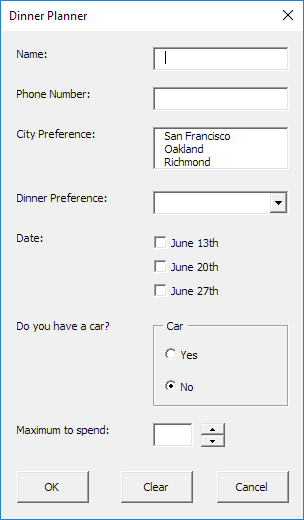
Excel Vba Userform Examples Free Download
In today’s example we’ll introduce data entry with the help of the UserForm. Using UserForm can considerably improve the interaction with our users. Furthermore this way we can assist them to execute particular steps. They play a very important role in the automatization of Excel. In these days none of the business dashboards can be imagined without Form Controls. Let’s say a few words about today’s task. At times data entry can be very boring and by this can incline users to mistakes.
E-STUDIO4515AC features, specs, drivers, downloads, tutorials and product information for Toshiba America Business Solutions (TABS) MFPs & Copiers. Toshiba Printer Drivers Download by Toshiba Corporation. Installs your drivers quickly and easily. You can scan for driver updates automatically with the FREE. Use the links on this page to download the latest version of TOSHIBA e-STUDIO166 drivers. All drivers available for download have been scanned by antivirus program. Toshiba e-studio166 drivers download, download and update your Toshiba e-studio166 drivers for Windows 7, 8.1, 10. Just download now! Toshiba e studio 166 scanner drivers free download. The Driver Update Tool – is a utility that contains more than 27 million official drivers for all hardware, including toshiba e-studio166 driver. This utility was recognized by many users all over the world as a modern, convenient alternative to manual updating of the drivers and also received a high rating from known computer publications.
Top 100 Useful Excel Macro [VBA] Codes Examples. You can break all the limitations of Excel which you think Excel has? Don't Forget to download this free PDF.
We’ll design a form that based on three data (Name, Age, Job title) will upload a “database”. Exactly as you can see on the picture below: What can exactly be seen on the picture? Three label, three text fields. And another thing, the Command Button. We’ll assign to this a simple macro that will store input data. How to create a UserForm to aid data entry?
The first step is to enter the Visual Basic Editor form the ribbon or by pressing the Alt+F11 buttons. Open the VBA Editor. If the Project Explorer is not visible, click View, Project Explorer. Click Insert, and select the Userform. After this place the fields and their names onto this form. Now insert the names of the fields by clicking on the Label Control button: As next step follow the TexBox belonging to the names. This option enables the data insertion. Change any elements and attributes of our form by right-clicking on them and then choose the Properties window.
As next step we have the option for example to set the fonts, size and colors. We can be all creative regarding the designs. We can make any kind we’d like or what we need for a given task. Now we will place another button on this form. Software efek gitar untuk pc gratis.
The purpose of this is to fix the given data on one Excel table. We do this by inserting the CommandButton from the Controls: Let’s see what the data entry form looks like now: The user interface is ready! Data input will be a lot easier from now on.
But we still have one very important thing to do. Because for the next step we have to determine the code behind it. In this example this would run by clicking on the “Add to list” button. Let’s right click the CommandButton.

From the drop down menu choose the View Code command. In the next chapter we’ll show how to assign a short VBA code to this. Adding Logic to Button in a Form Let’s clear what do we expect from the code after clicking on the button? Our expectation will be that it inserts the values of the UserForm into the determined cells of the determined rows. For this we have to know where the next empty line in the table is.
After the insertion we have to equal the appropriate cells to the input values of the appropriate fields. To begin let’s define two variables. The first one with Integer type by the name rw to determine the current, still empty rows. The second one by the name ws and with type Worksheet. This will determine which worksheet our form will refresh / update the cells. We can already set the calues of the latter variable onto Sheet1. Use the Range Find method to determine the starting value of our rw variable.
In our case we have to use the ws.Cells.Find method, because we are looking amongst the cells of Sheet1 that contains anything (What:=”*”). We search by rows (SearchOrder:=xlRows) for the row containing the last (SearchDirection:=xlPrevious) value (LookIn:=xlValues).
Than we add one to this number to find the first empty row: rw = ws.Cells.Find(What:=”*”, SearchOrder:=xlRows, SearchDirection:=xlPrevious, LookIn:=xlValues).Row + 1 And from this point on our task is basically easy. The written value in the field must be equal with the rw variable. We store the number of the cells in the rw variable. We can find out the names of our fields from the UserForm Properties window in case we did not use standard names for them. Therefore, ws.Cells(rw, 1).Value (this is the cell of Sheet1 first empty row in the first column) be equal to Me.TextBox1.Value which is the value was given into our first field. Me always refers to the parent object that we “have” our code. In this case it refers to UserForm, but if we was to write our code on a Sheet, that it would refer to that.